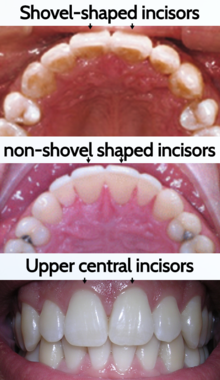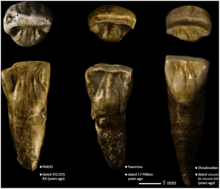Shovel-shaped incisors
Shovel-shaped incisors (or, more simply, shovel incisors) are incisors whose lingual surfaces are scooped as a consequence of lingual marginal ridges, crown curvature or basal tubercles, either alone or in combination.

Shovel-shaped incisors are significantly common in Amerindians from North, Central and South America. They are also common in East and Central Asians, Hungarians, the Eskimo and Aleut peoples of Northeast Asia and North America (including but not limited to the Inuit peoples of eastern Alaska, arctic Canada and Greenland).[1][2][3][4] In Europeans and Africans, shovel-shaped upper incisors are uncommon or not present.[1] There is a spectrum of the degree of shoveled-ness, ranging on a scale from 0 to 7 of spatulate incisors to shoveled incisors.[1] It was theorized that positive selection for shovel shaped incisors over the spatulate incisors are more commonly found in anthropoids within cultures that used their teeth as tools due to a greater structural strength in increased shovel shaped incisors.[1] However, more modern research suggests that instead genetics plays a role in the degree of shoveled-ness. There have been reports where Non-Asiatic Groups such as Europeans, Sub Saharan Africans, and South Asians, having Shovel Shape Teeth, but that could be the case of having East Asian or Native American Ancestry[5]
In some instances, incisors can present a more pronounced version of this called double shovel-shaped. When present, shovel-shaped incisors can indicate correlation among populations and are considered to be one of the non-metrical traits in osteology. Structurally resembling the shovel-shaped incisors, double-shovel-shaped incisors are distinguished by a more pronounced mesial ridge comparing to the distal ridge. Similarly, the grades for both shovel-shaped incisors and the double shovel-shaped incisors in females are significantly greater than that in males.[1]
Shovel-shaped dental characteristic are also observed in Homo erectus like the Peking Man and in Neanderthals, although the morphology of these shoveled incisors is distinct from the modern human form of shoveling.[6][7][8] The morphology of Neanderthal's anterior teeth has been seen as an adaptation to the heavy use of their canines and incisors in processing and chewing food, and the use of their teeth for activities other than feeding.[9]
Genetics
Variation in modern human incisor shoveling has been associated with the presence/absence of the V370A allele of the Ectodysplasin A Receptor (EDAR) gene.[2][1][10][11] The EDAR V370A isoform arises from a single nucleotide polymorphism/missense mutation which changes the 370 Valine residue to an Alanine on the EDAR gene.[10] The effect is approximately additive, where individuals with one copy of the allele have intermediate expression of shovel-shaped incisors and homozygotes have more strongly shoveled incisors.[10] The trait is pleiotropically related to thicker and straighter hair shafts, other dental traits, sweat glands, and mammary gland ductal branching.[12][10][1] An earlier quantitative genetic analysis of a Finnish population also revealed that inheritance of incisor shoveling is monogenic.[13] The 1540C allele of EDAR is also strongly correlated with the presence of shovel-shaped incisors and hair thickness, as found in a study conducted on the DNA from Japanese populations.[1] People with Amerindian or East Asian ancestry have thicker and straighter hair.[2]

It is hypothesized that other pleiotropic effects associated with the V370A allele were favored by natural selection to help promote the presence of the allele and thus the emergence of shovel-shaped incisors. One of these associated traits is increased ductal branching in the mammary gland, which improves nutrient transport in breastmilk. This may likely have conferred a survival advantage to those with the allele during the Last Glacial Maximum in certain environments with high altitudes and low Vitamin D.[5]
History

The first description of shovel-shaped incisors was in 1870.[14] During the 20th century, it was accepted that incisor shoveling yielded a direct advantage to the possessor. The proposed explanation for this at the time was that shovel-shaped incisors were stronger than non-shovel shaped incisors, resulting in the evolution of shovel-shaped incisors in regions where having stronger teeth would provide an evolutionary advantage.[15][16] The greater size and mass of shoveled incisors was said to have provided increased strength and durability as a means to prevent breakage.[17] However, current research shows that part of the genotype, the EDAR gene, which was selected for because of its role in nutrient transfer in breast milk during the era of the Beringian refugium, also determines the degree to which teeth shovel.[5] In an interview, Dr. Hlusko suggests that human populations who had the trait migrated from Asia to the Americas, thus leaving their genetic trace around the world. With greater implications outside shoveling itself, the human variation in shoveling also supports the idea that populations are dynamic, rather than the theory of static populations evolving separately and distinctly.[18]
Applications
In the mid 20th century, shovel-shaped incisors were considered to be a trait useful for racial categorization, since the occurrence of shovel-shape incisors varies between many populations.[19] A 1964 text said that many anthropologists at the time used the trait of shovel-shaped incisors as a diagnostic for race.[19]
The presence of shovel-shaped incisors, among many dental characteristics, is utilized in forensic dentistry to identify an individual’s ancestry.[20] In particular, this trait occurs predominantly in Asian and Native American populations.[21]
See also
References
- Kimura R, Yamaguchi T, Takeda M, Kondo O, Toma T, Haneji K, Hanihara T, Matsukusa H, Kawamura S, Maki K, Osawa M, Ishida H, Oota H (October 2009). "A common variation in EDAR is a genetic determinant of shovel-shaped incisors". American Journal of Human Genetics. 85 (4): 528–35. doi:10.1016/j.ajhg.2009.09.006. PMC 2756549. PMID 19804850.
- "Amerindians and Asians carry a version of the EDAR gene that is linked to shovel-shaped incisors and thicker hair shafts".
- Acs G, Pokala P, Cozzi E (1992). "Shovel incisors, three-rooted molars, talon cusp, and supernumerary tooth in one patient" (PDF). Pediatric Dentistry. 14 (4): 263–4. PMID 1303528.
- DeLong L, Burkhart NW (2008). General and Oral Pathology for the Dental Hygienist. USA: Lippincott Williams & Wilkins. p. 494. ISBN 9780781755467.
- Hlusko LJ, Carlson JP, Chaplin G, Elias SA, Hoffecker JF, Huffman M, Jablonski NG, Monson TA, O'Rourke DH, Pilloud MA, Scott GR (May 2018). "Environmental selection during the last ice age on the mother-to-infant transmission of vitamin D and fatty acids through breast milk". Proceedings of the National Academy of Sciences of the United States of America. 115 (19): E4426–E4432. doi:10.1073/pnas.1711788115. PMC 5948952. PMID 29686092.
- "The fossil teeth of the Peking Man".
- "Beyond shovel-shaped incisors: Neandertal dental morphology".
- Bailey S (October 2006). "Beyond shovel-shaped incisors: Neandertal dental morphology in a comparative context". Periodicum Biologorum. 108 (3): 253–67.
- Clement AF, Hillson SW, Aiello LC (March 2012). "Tooth wear, Neanderthal facial morphology and the anterior dental loading hypothesis" (PDF). Journal of Human Evolution. 62 (3): 367–76. doi:10.1016/j.jhevol.2011.11.014. PMID 22341317.
- Park JH, Yamaguchi T, Watanabe C, Kawaguchi A, Haneji K, Takeda M, Kim YI, Tomoyasu Y, Watanabe M, Oota H, Hanihara T, Ishida H, Maki K, Park SB, Kimura R (August 2012). "Effects of an Asian-specific nonsynonymous EDAR variant on multiple dental traits". Journal of Human Genetics. 57 (8): 508–14. doi:10.1038/jhg.2012.60. PMID 22648185.
- Tan J, Peng Q, Li J, Guan Y, Zhang L, Jiao Y, Yang Y, Wang S, Jin L (May 2014). "Characteristics of dental morphology in the Xinjiang Uyghurs and correlation with the EDARV370A variant". Science China Life Sciences. 57 (5): 510–8. doi:10.1007/s11427-014-4654-x. PMID 24752358.
- Kamberov YG, Wang S, Tan J, Gerbault P, Wark A, Tan L, et al. (February 2013). "Modeling recent human evolution in mice by expression of a selected EDAR variant". Cell. 152 (4): 691–702. doi:10.1016/j.cell.2013.01.016. PMC 3575602. PMID 23415220.
- Portin P, Alvesalo L (July 1974). "The inheritance of shovel shape in maxillary central incisors". American Journal of Physical Anthropology. 41 (1): 59–62. doi:10.1002/ajpa.1330410108. PMID 4843087.
- Saukko P, Knight B (2004). Knight's Forensic Pathology (3rd ed.). USA: Taylor & Francis Group. p. 533. ISBN 9780340760444.
- Hooijer DA (1948). Prehistoric Teeth of Man and of the Orang-utan from Central Sumatra, with notes on the Fossil Orang-utan from Java and Southern China. EJ Brill.
- Hrdlička A (October 1920). "Shovel-shaped teeth". American Journal of Physical Anthropology. 3 (4): 429–465. doi:10.1002/ajpa.1330030403. ISSN 0002-9483.
- Dahlberg AA (September 1963). "Dental Evolution and Culture". Human Biology. 35 (3): 237–49. JSTOR 41448607. PMID 14063186.
- Sanders R (2018-04-23). "Did last ice age affect breast feeding in Native Americans?". Berkeley News. Retrieved 2018-11-07.
- Suzuki M, Sakai T (March 1964). "Shovel-shaped incisors among the living Polynesians". American Journal of Physical Anthropology. 22 (1): 65–71. doi:10.1002/ajpa.1330220117. PMID 14218893.
- Pretty IA, Sweet D (April 2001). "A look at forensic dentistry--Part 1: The role of teeth in the determination of human identity". British Dental Journal. 190 (7): 359–66. doi:10.1038/sj.bdj.4800972. PMID 11338039.
- Jodi B (2000). "Racial Identification in the Skull and Teeth". Totem: The University of Western Ontario Journal of Anthropology. 8 (1): 4.